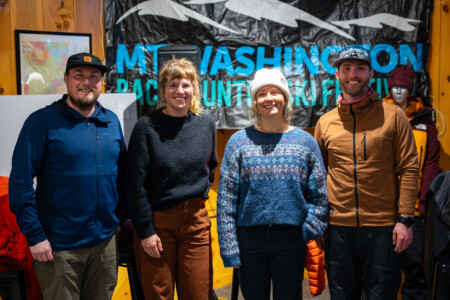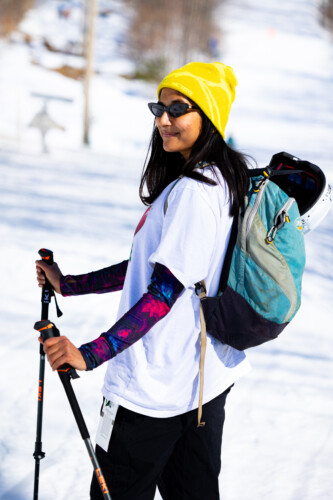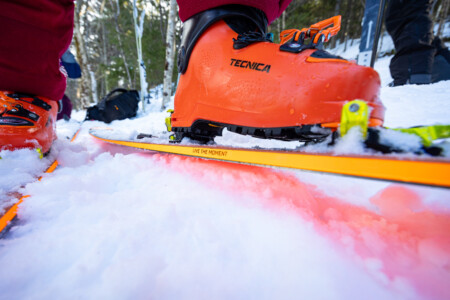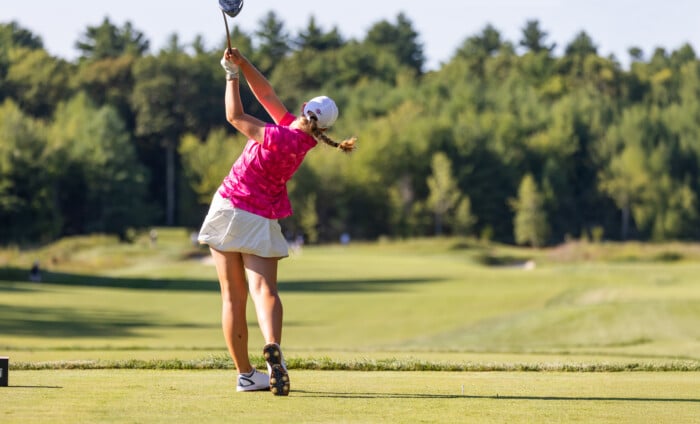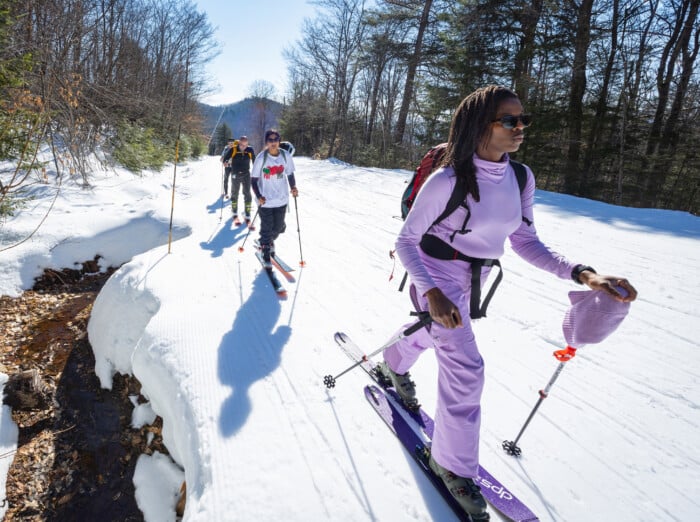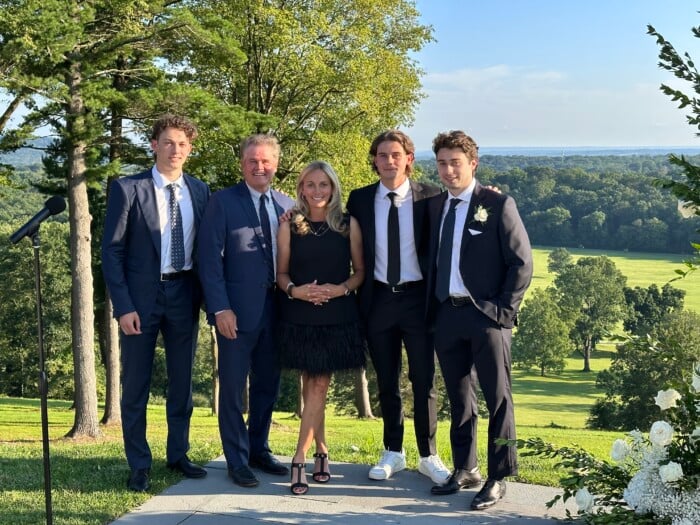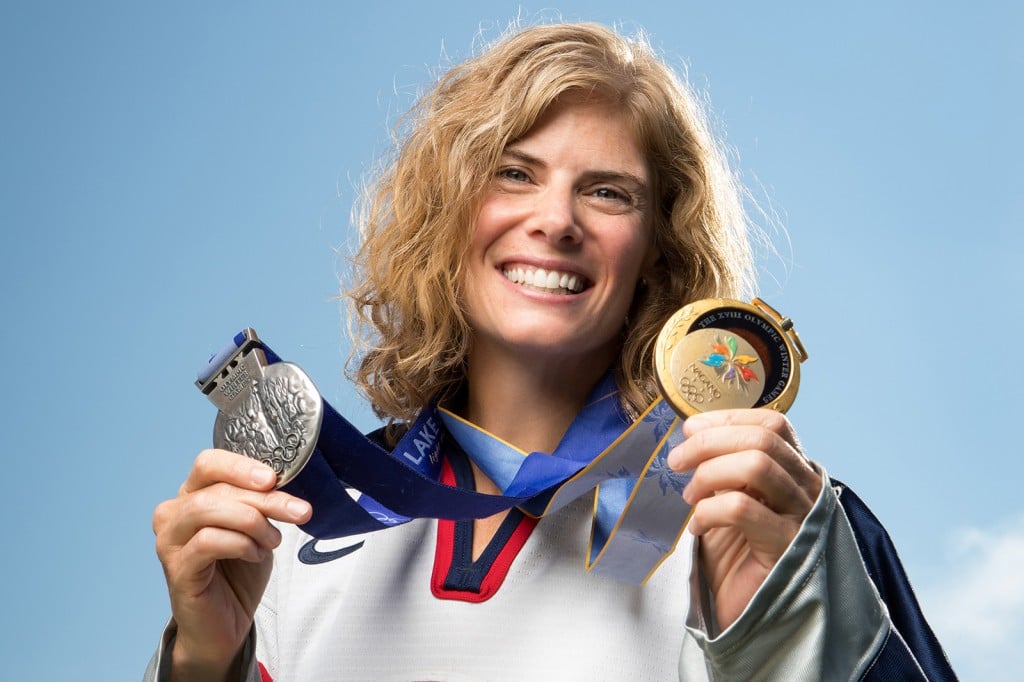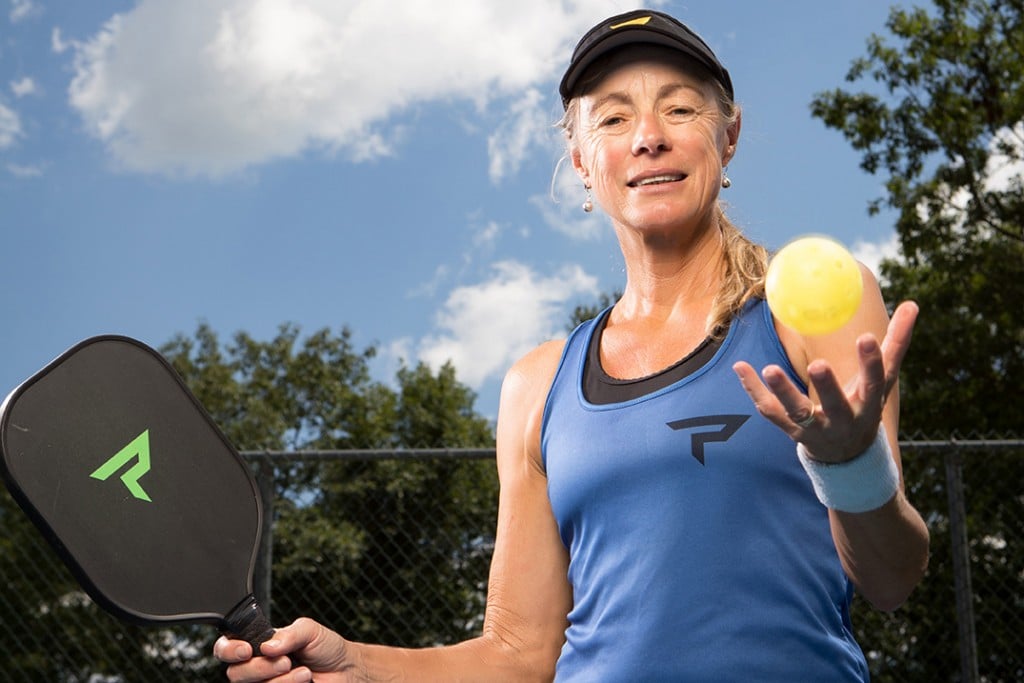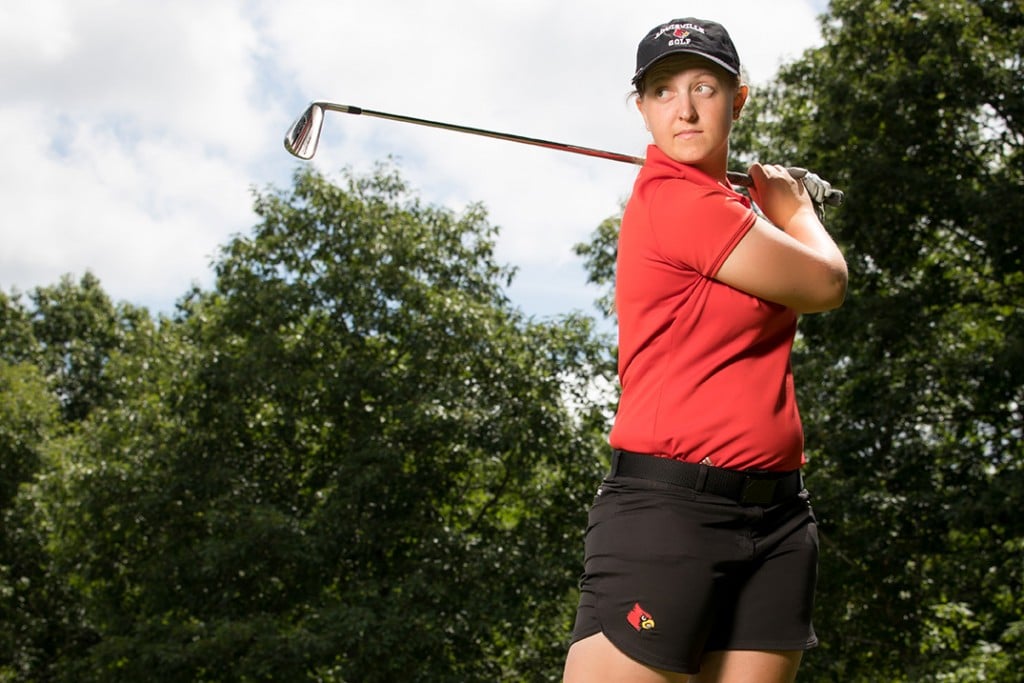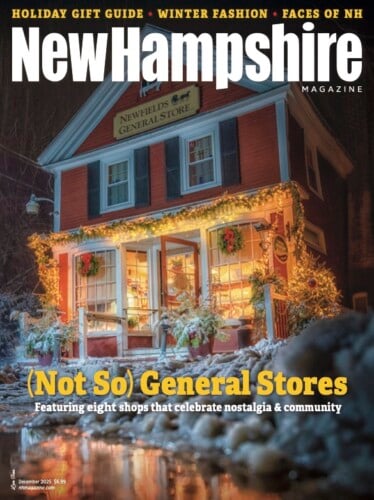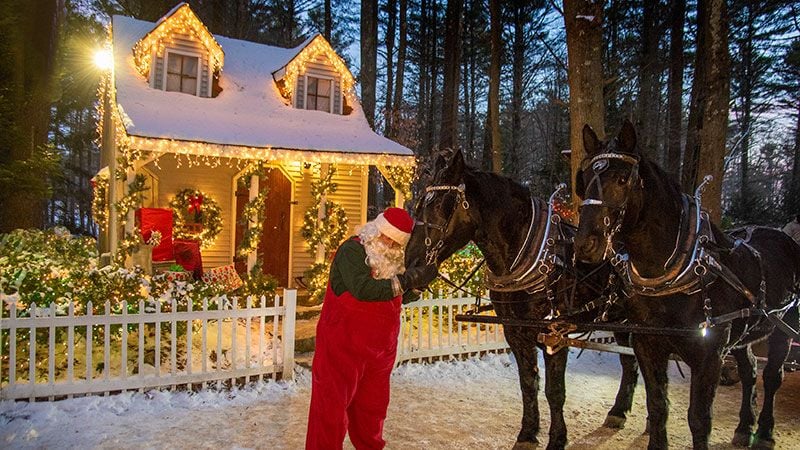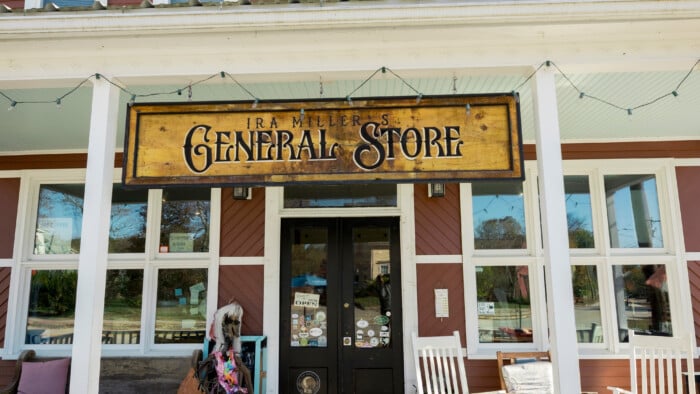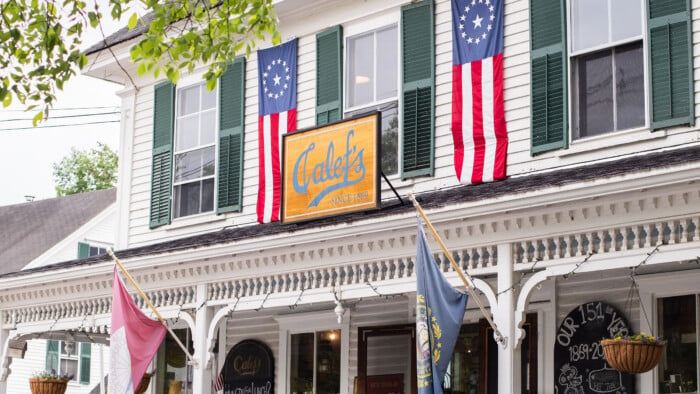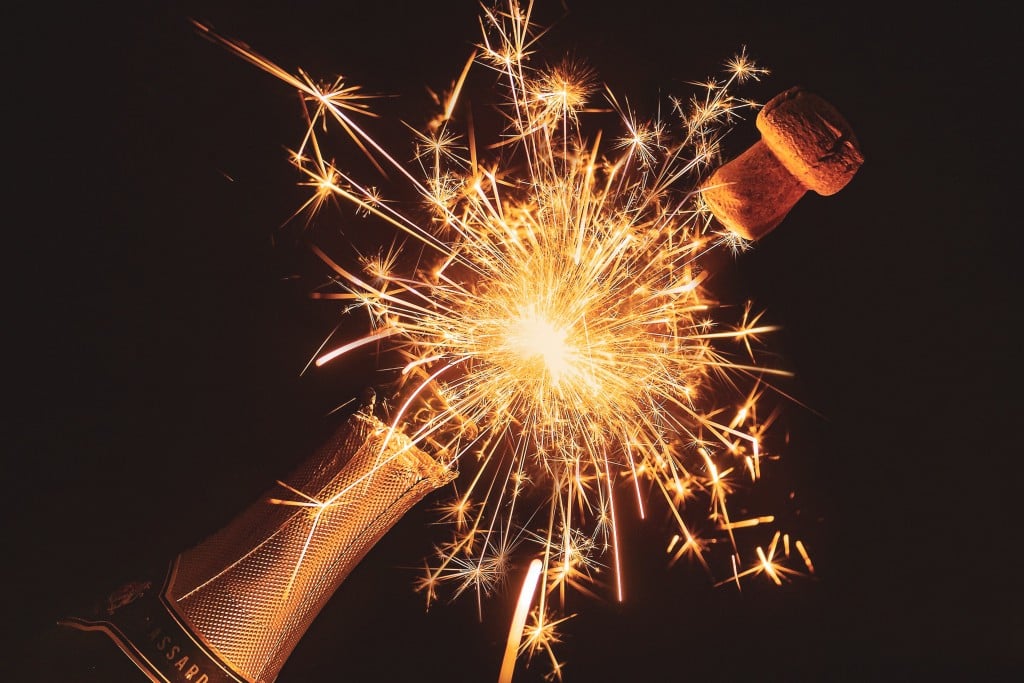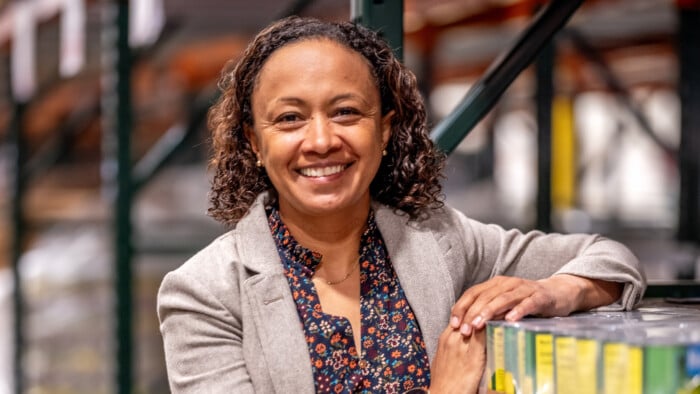Elevated Connections: Women in the Wild at Mount Washington
Inside NH's Mount Washington Backcountry Ski Festival, and the all-women's course for female skiers and split boarders who want to grow their backcountry skills and explore the White Mountains.
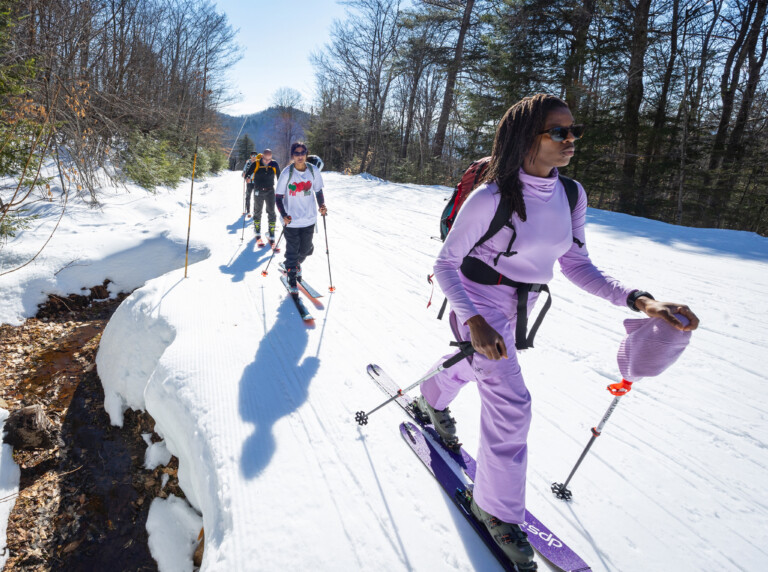
On an exposed outlook adjacent to the Cog Railway, our group marveled at the Lakes of the Clouds mountain hut perched on the snow-covered ridgeline above.
While sipping from our water bottles and chomping on chilled granola bars, we began transitioning our equipment in preparation for our single ski run of the day, one that we had certainly earned from the 3-mile ascent up Mount Washington’s western-facing slope.
It was a mild Saturday in early February last year, and I had joined professional skier and The North Face athlete, Caite Zeliff for “Women of the Wild,” an all-women’s course offered during the Mt. Washington Backcountry Ski Festival, intended for female skiers and splitboarders who want to grow their backcountry skills and explore the White Mountains.
Backcountry skiing, often done with alpine touring gear, involves climbing uphill by attaching adhesive “skins” to the base of each ski. At the top of the climb, skiers remove the skins and lock their heels into place before skiing down.
In a similar fashion, snowboarders use what’s known as a splitboard, or a snowboard that literally splits in half, functioning as two skis for the climb. Before descending, the board is reassembled and the bindings are transitioned into a sideways stance.
First held in 2017, this annual backcountry festival boasts immersive experiential opportunities led by notable outdoor guides and professionals. This year’s festival is scheduled for February 21-23.
Courses such as last year’s “BIPOC Beginner Ski Tour,” “Splitboarding Beginnings: Discovering the White Mountains’ Backcountry,” and “Ski Mountaineering Unleashed” provide options for true backcountry beginners to seasoned winter enthusiasts seeking to push their boundaries.
The festival also deep-dives into creative careers in the outdoor industry with Outdoor Office, a two-day program mentored by freelance writers, photographers and videographers, giving students real-world, hands-on experiences.
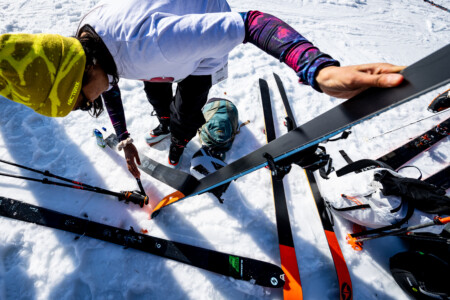
A participant removes the adhesive skin, or traction device, from the bottom of her ski, transitioning from uphill mode to downhill mode.
In recent years, the festival has featured an athlete from top sponsor The North Face, bringing in freeskiing champion Griffin Post in 2023 and, more recently, Zeliff, whose accolades include a two-time Queen of Corbets competition title, first place at the Nendaz Freeride Qualifying Tour, and multiple video parts for household names in the ski industry, such as Warren Miller and Teton Gravity Research.
Originally from North Conway, Zeliff learned to ski at Cranmore Mountain Resort and knew she wanted to return to her roots for an event in the ski community. Not long after some scheming with family friend Tyler Ray, a major festival facilitator (who stepped down last spring), Zeliff received a call from her team manager at The North Face asking her to be the featured athlete for the 2024 backcountry fest.
“I was psyched,” she said over coffee that morning. “This place has given me so much. The ski community has been super supportive from fundraising to help pay for ski racing when I was a kid. It’s an honor to be home.”
Located in Intervale just north of North Conway Village, Ledge Brewing Company has operated as the festival’s home base, where participants meet their guides and group members first thing each morning.
As someone who has participated in the festival in years past, I knew upon arriving that we would ease into our day first with introductions, sharing a bit about our lives and our backcountry skiing experience. This would allow our guides to shape and modify the plans for the day’s adventure, depending on the overall skill level and comfort of the group.
Passing by the lengthy bar into a back room used for live music events in the evenings, I found Zeliff along with backcountry professional Allie Rood seated around a table, colorful ski jackets and snow pants adorning the backs of chairs, and backpacks with their contents spilling out onto the floor.
I was soon joined by Hilary White, whose partner introduced her to backcountry skiing only a year prior. Although White initially had her reservations about the skill level required of participants in this course, the description stated that “skiers should be able to make controlled turns on narrow backcountry trails and glades” — she knew she had to give it a try.
“I think the coolest thing was, there were people of a lot of different levels,” White said of our group later in the day. “It felt like there was a place for everyone.”
Considering skill level, weather forecast and mountain conditions, we landed on a final plan to ascend alongside the Cog Railway to Jacob’s Ladder, a long and tall trestle about two-thirds of the way up to Mount Washington’s summit. Not long after, we were off.
Our skis glided rhythmically against a groomed track leading to the base of the railway where we would begin our climb. Moving at a comfortable pace, participants settled into smaller groups, chit-chatting about all facets of life, from old injuries to relationship advice to base-layering tips and tricks.
Despite the festival being held during the second week in February, the 50-degree temps and the warming breaks of sunshine forced us to unzip vents in our jackets and remove midlayers, some of us comfortable in T-shirts alone under bib-style snow pants.
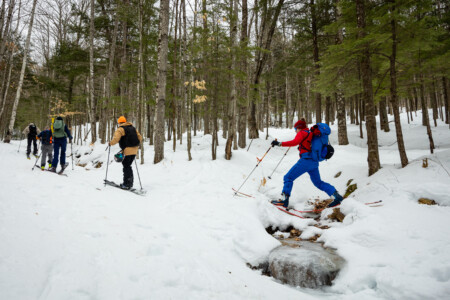
The “Outdoor Office” team ventures outdoors and into the glades at Maple Villa, learning how to make photos and videos while backcountry skiing.
Nearing Waumbek Station at 4,000 feet, the final destination for the railway locomotives in winter, I filed in alongside Elizabeth Burakowski, a fellow splitboarder and the only other rider in our group of skiers.
A climate scientist at the University of New Hampshire, Burakowski was first introduced to the community when she spoke about the warming winters in New England at Wild Corn, an annual spring shindig hosted by the Granite Backcountry Alliance. GBA, a nonprofit organization committed to advancing opportunities for backcountry skiing in northern New England, is a major supporter of the festival.
Burakowski would be addressing festival participants about climate trends in New England at the High George Jamboree later that evening, the festival’s culminating celebration. One of several featured speakers, she was scheduled to present alongside Outdoor Office director Sarah Lamagna, lifelong backcountry adventurer and racial equity advocate Mardi Fuller, and of course, Zeliff with her keynote address.
When I asked her about the future of an event such as the Mt. Washington Backcountry Ski Festival, she seemed hopeful.
“I feel like we’ve turned a corner in terms of renewable energy,” she shared, the shush of our skis background noise to our conversation. “I hope that folks see that our actions matter and that we can turn this bus around.”
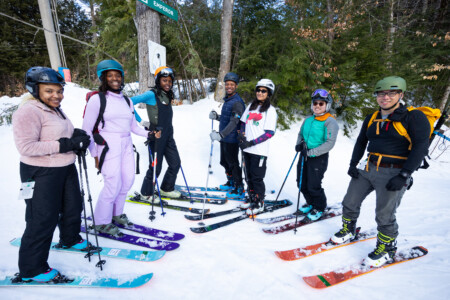
Saturday saw a great turnout for the BIPOC Beginner Uphill Tour led by mountaineer Mardi Fuller (second from the left).
At the end of our ascent, we crossed underneath the trestle to a rocky outlook overlooking Ammonoosuc Ravine and a few summits of the Presidential Range, sprawling southward. Here, we unstrapped from our equipment, settled our packs in the snow and hopped from one rock to another, laughing and enjoying the surrounding peaks visible under high clouds.
Burakowski pointed out how the light framed the mountain hut on the ridge above, returning to the scene later as a highlight of the day. “It was one of those moments where you’re like, ‘Ya, this is winter.’ This is why I study climate and want to work to protect it.”
After refueling and a few photo opportunities, we crossed back under the trestle for the well-earned run down. We descended, one by one, with Zeliff leading the charge, carving the edge of her skis into the snow to cut back and forth across the trail in a hypnotic and laid-back style.
The conditions were soft and forgiving, like skiing through a giant pool of mashed potatoes, and while they certainly made for a fun run, we weren’t quick to forget that those conditions were more characteristic of late March than early February.
Of all the stories I heard that day, I found myself most inspired by Meaghan Cassily-Moody, who was returning to Mount Washington for the first time after a major injury set her back 10 years prior. In short, another skier landed on top of her while they were descending the Sherburne Ski Trail in Pinkham Notch, severing two muscles in her quad right above the knee cap.
“I love skiing, but I was terrified to go up there again,” she said at the end of our outing, notifying many of us for the first time that day of this personal achievement. “Without the support of ladies, I would not have made it up to the top.”
“I just like the support of like-minded women where there’s no judgment,” Cassily-Moody continued. “There’s so much judgment in this world and social media creates falsities where you can’t really get back to like a core self, and in nature you can. I’m just really lucky to have decided to come today.”
“It was so cool to hear everyone remarking on how great that experience was,” Rood added from the parking lot as we removed our boots and began shoving our gear into the back of the SUV. “And it all comes down to the interpersonal kind of connections we had.”
Currently a full-time videographer, Rood has started the intense training required to become a full-time ski guide.
“I think the best days for me are when I get to share the mountains with other people and see a level of empowerment that really makes every day special. Like today was just such a great example of how my cup was completely brim full being out there with everyone.”
Nodding in agreement, Zeliff shared Rood’s sentiment: “I feel like it’s so sweet, seeing people get elated by something I love so much and sharing that with somebody and being like, ‘Isn’t this the best?’ That definitely gets me psyched up, for sure.”
Back at the brewery, we stood around a high-top table, enjoying a beverage and Ledge’s made-to-order tacos (I recommend ordering the carnitas al pastor). With rosy cheeks and disheveled hair, we said cheers to a day well-spent with new friends in the mountains, elated with the challenge we’d overcome together.
On Sunday morning, I returned to the brewery for my second and final course of the weekend: “Whispering Woods: The Ultimate White Mountain Glade Ski Experience.”
Designed for skiers and splitboarders eager to explore gladed terrain in the White Mountains, the course involved reviewing gear fundamentals, analyzing weather and avalanche reports, and developing skills such as safe route finding through forested terrain. An intermediate course and extensive resort experience in addition to previous backcountry experience was required of participants.
The morning was slow and casual. The previous day’s thaw had refrozen overnight, making for dicey conditions all over the Mount Washington Valley.
This group was smaller, with four participants total and two guides. Skier Jordan Cargill, owner and head guide of Mountain Shadow Adventures, and local splitboard guide Adam Freierman teamed up to led the charge on the final day of the festivities.
“I really like the community aspect of it,” said Cargill about guiding for the festival. In addition to Sunday’s offering, Cargill led a hidden gems tour for experienced skiers. The festival’s first introductory backcountry tour centered around the identities and experiences of BIPOC individuals. (BIPOC is an acronym for Black, Indigenous and people of color, to show solidarity between communities of color.)
“Working as a guide full-time, I find a lot of value in being a part of people’s new experiences. To help facilitate that, it’s really rewarding,” he said.
Although Freierman has lived and skied in the valley for almost a decade, he admits to shying away from the community-based aspect of backcountry skiing at times. “The festival seemed like a good way to re-engage and get some fresh perspectives on being in the mountains and sharing that with some people who bring fresh energy that I wouldn’t get otherwise.”
For our morning session, we decided to make our way over to the Doublehead Ski Trail since it had yet to be checked off any of our lists for gladed ski opportunities in the area. This popular backcountry route — approximately 3.5 miles out and back on an old Civilian Conservation Corps trail — is a straightforward ascent with a moderately steep section nearing the top.
Faced with a firm snowpack and solid moguls to manage (it had been quite some time since the most recent fresh snowfall), we made the best of it.
Cargill advised us to put our weight into our heels on steeper inclines, a move that seemed counterintuitive yet proved effective. For the most part. A few “uh ohs” sounded from the back of the pack as one or two of us slipped backward on the icy slope into a tree trunk on the side of the trail or, better yet, each other.
Despite these hiccups, we laughed it off, the positive energy of the group making it easy to push onward and upward.
Doublehead Cabin sits at the 3,000-foot summit at the end of the trail. Around the cabin, the deep snowpack was filled with hardened post-holes likely from the previous day’s visitors. The surface was now so firm and slick, that I had to use my poles to navigate around the hut as we chatted with skiers outside of our group and meandered toward the backside of the cabin for a view of snow-capped peaks through a clearing in the pines.
Chatting with skiers Kim Giles and her partner, Jesse Stevenson, at the top, I learned that they have participated in the festival for the past two years, and first started backcountry skiing a few years before that.
“Honestly, it’s just a good way to get out and meet people, and to see new areas that we want to do ourselves,” Giles said. “We push ourselves more than I would if I was just by myself.”
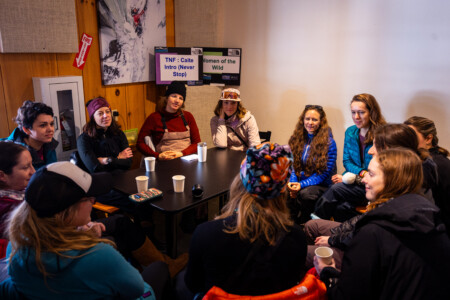
Skiers and riders participating in the “Women in the Wild” tour chat specifics before heading out to Mount Washington.
Descending, we took it slowly and cautiously, side slipping on the edges of our boards and skis in the steep areas leading into sharp turns. At the bottom half, the incline mellowed and the snow softened, quieting the nervous laughs of our group members as they tackled the challenging conditions.
Although backcountry skiing can be trying, many are drawn to the sport for the satisfaction it instills.
“I never felt super fulfilled on a day at a resort,” skier Josh Deems said. “It was always just like, ‘this is cool, but it’s not exactly what I want to be doing because I really enjoy hiking and the exercise that comes with it.’ I feel like I don’t get that at a ski resort the same way.”
With rising lift ticket costs and crowding at resorts, many recreationists, like Deems, have turned to human-powered skiing and snowboarding for a more meaningful experience in the mountains.
“It’s really awesome to hear everybody’s stories and hear how they like to engage with the mountains and outdoor space,” Freierman said.
Pausing for a quick sip of water and taking advantage of the break in conversation, I marveled at the sunlight casting shadows off the trunks of pine and birch, the dark lines stretching across the white and glittering surface of snow, and inhaled fully before nodding to my companions that I was ready to go, initiating tired legs and leading the final stretch back to the car.
